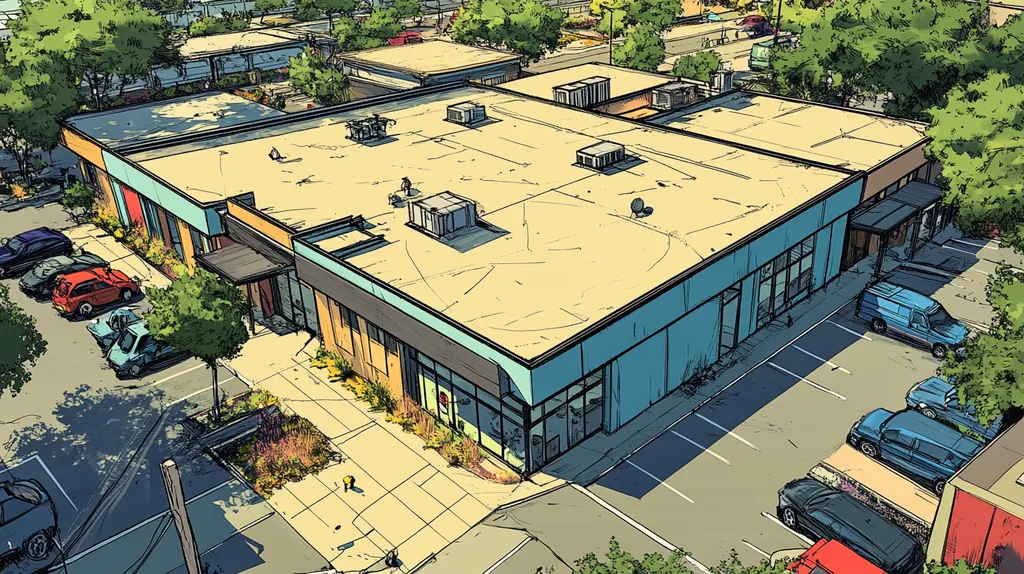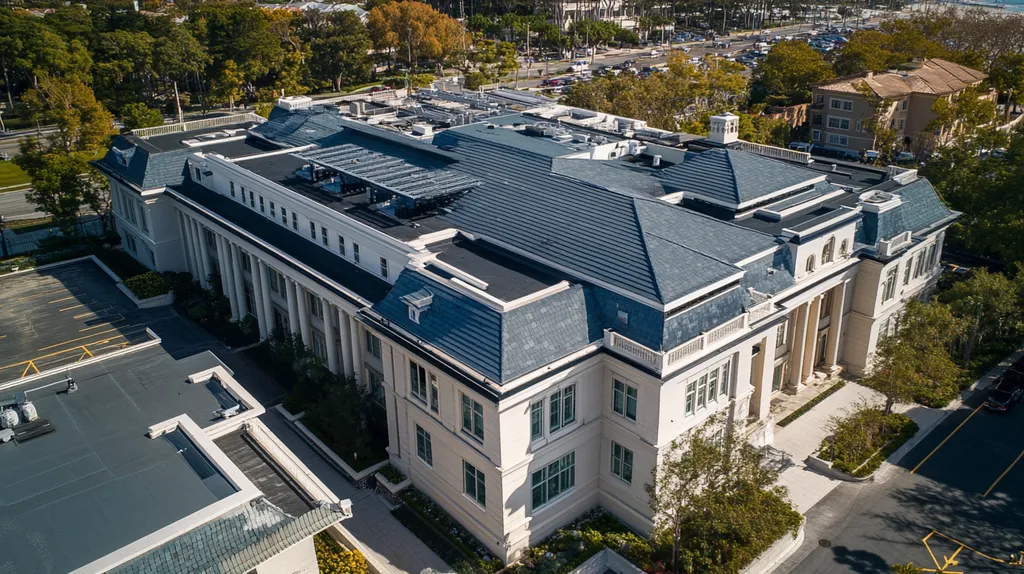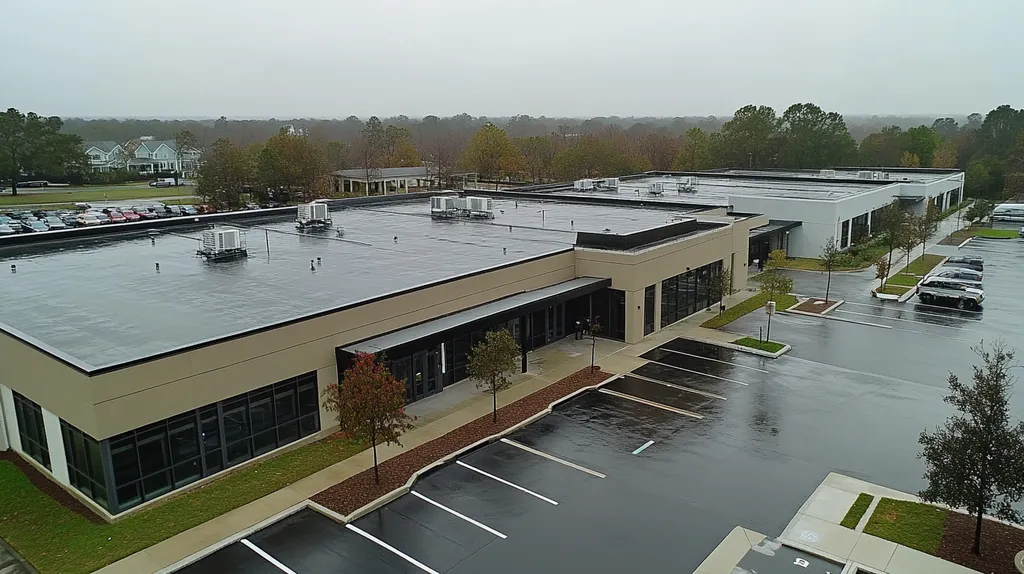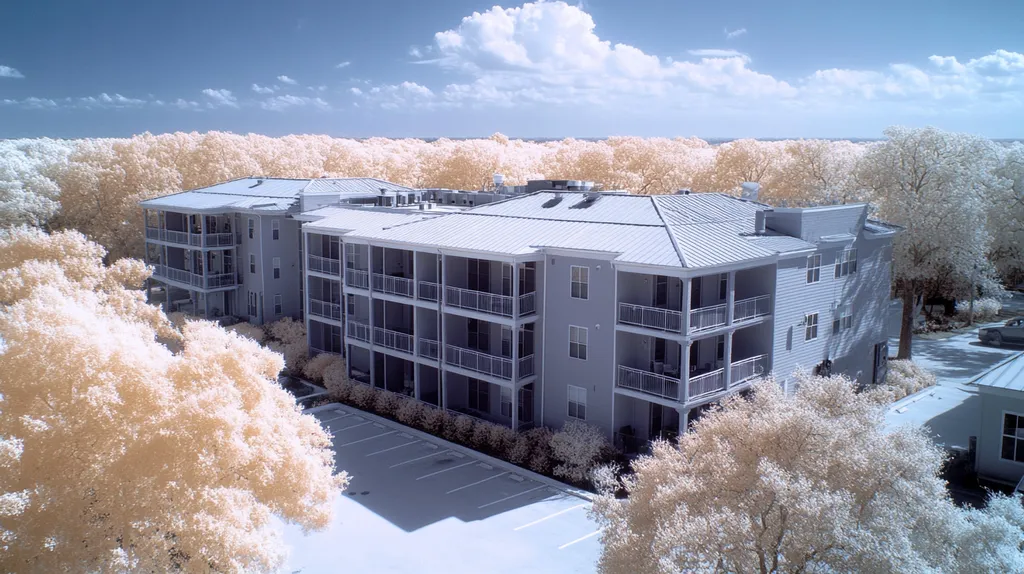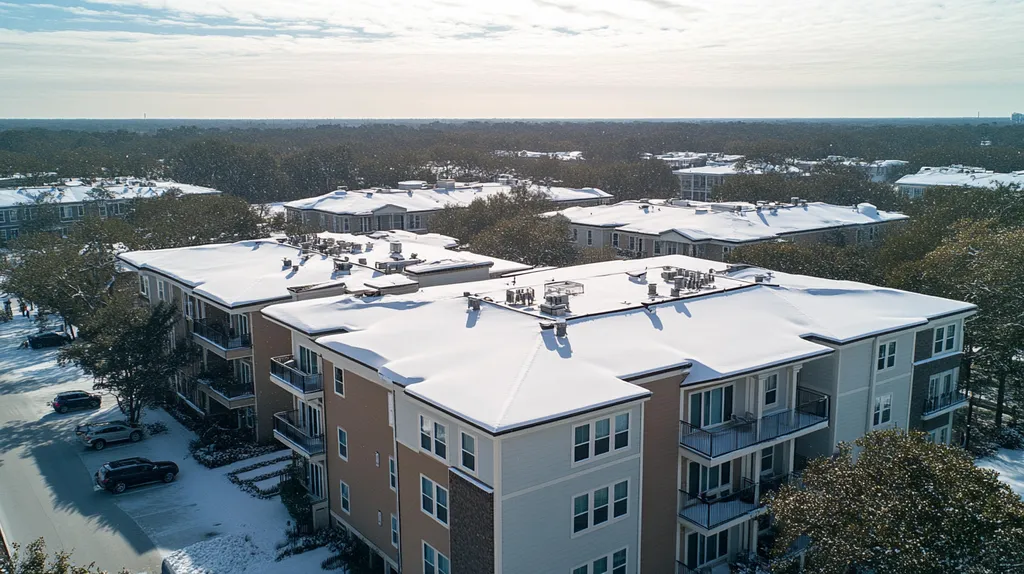The mishandling of hazardous materials during commercial roof repairs leads to over 2,000 workplace incidents annually, resulting in severe injuries and costly regulatory violations.
From aging asbestos-containing materials to toxic adhesives and lead-based coatings, modern roofing contractors face an increasingly complex landscape of dangerous substances requiring specialized knowledge and careful management.
This comprehensive guide examines the critical aspects of hazardous material handling, breaking down essential safety protocols, regulatory requirements, and best practices that every roofing professional must understand to protect workers, building occupants, and the environment.
SECTION 1: THE BASICS EXPLAINED
Understanding how to handle hazardous materials during commercial roof repairs is imperative for maintaining the safety of both workers and building occupants. The potential dangers posed by substances such as asbestos and lead are well-documented, with the Environmental Protection Agency (EPA) enforcing strict regulations to mitigate risks. Following these standards is not merely about compliance; it’s about preventing severe fines and safeguarding human health. This section will break down what hazardous materials are, why their proper handling is vital for your building, and the essential steps for safe execution.
What It Is (In Plain Language)
Hazardous materials refer to substances that can pose risks to health or the environment. In the context of roofing, common examples include asbestos, lead-based paints, and certain chemicals used in adhesives. These materials necessitate specialized handling protocols to ensure safety during any repair or removal process.
Simply put, hazardous materials can be seriously harmful when disturbed. For instance, during roof repairs, disturbing asbestos-containing materials can release microscopic fibers into the air, posing a threat not only to workers but also to nearby occupants and residents who may be unaware of the danger.
Beyond immediate health effects, hazardous materials can lead to long-lasting environmental issues. Improper disposal practices can contaminate soil and water, causing broader environmental harm. Recognizing which materials are classified as hazardous is a crucial initial step toward implementing safe roofing practices.
By proactively identifying hazardous materials, roofing contractors can take necessary precautions to prevent accidents, thereby protecting their teams and the communities they serve.
Why It Matters (To Your Building)
Proper handling of hazardous materials is crucial in a commercial setting where the stakes are high for human health and safety. Properties containing hazardous substances come with legal responsibilities that must be met to ensure regulatory compliance. Noncompliance can lead not only to substantial fines but also to costly litigation.
Additionally, the reputation of a commercial property is adversely affected when hazardous materials are mishandled. Incidents of exposure can generate negative publicity, dissuading potential tenants or occupants and damaging the building’s credibility.
The financial ramifications can be significant. Properties known to harbor hazardous materials may find it more challenging to obtain insurance or financing, impacting their market value and the owner’s overall return on investment.
Thus, ensuring the safe handling of hazardous materials is essential for protecting everyone involved, preserving compliance, and maintaining the operational integrity of a building. Facility managers must embrace effective hazardous material strategies to safeguard lives and business interests alike.
How It Works
Safe handling of hazardous materials involves several crucial steps, starting with identification. Roofing contractors must assess the work site to locate any hazardous materials, often employing visual inspections and lab testing as needed.
Once materials are identified, a thorough planning phase follows, resulting in a comprehensive risk assessment and handling strategy. This plan details procedures for safe removal or containment, including the use of appropriate personal protective equipment (PPE) and ensuring adequate ventilation during work.
Education is another essential component in implementing effective hazardous material handling. All workers must be trained to recognize hazardous substances and understand the associated risks. This knowledge enhances their awareness and serves as a preventive measure against potential incidents.
Finally, proper disposal is a non-negotiable area where adherence to regulations is critical. Hazardous waste must be disposed of correctly, typically requiring specific permits and transportation by certified waste disposal companies to ensure both environmental safety and legal compliance.
By rigorously following these steps, roofing contractors can effectively manage hazardous materials, protecting their workers, the buildings they serve, and the surrounding communities.
SECTION 2: PRACTICAL APPLICATIONS
When it comes to commercial roof repairs, handling hazardous materials isn’t just about following the law—it’s an essential aspect of safeguarding the health of workers and building occupants. According to the Occupational Safety and Health Administration (OSHA), improper management of these materials can result in serious accidents, health risks, and significant legal repercussions. This section will delve into common hazardous materials you may encounter, highlight the most critical moments for their safe handling, and examine how these materials interact with other building systems.
Common Uses & Examples
In the roofing industry, hazardous materials are not uncommon. Some of the most frequently encountered substances include asbestos, lead-based paints, and various chemical adhesives. As an example, asbestos is often present in older roofing materials and poses grave respiratory risks if disturbed. Lead-based paints, typically found on metal roofs, can also be toxic, particularly during repair processes.
Chemical adhesives, such as those containing isocyanates, are widely used yet can release harmful vapors if mishandled. It’s crucial for property owners to familiarize themselves not only with the potential risks but also with the specific hazardous materials that may be present on their roofs. This knowledge is key to implementing effective safety measures.
When You Need It Most
The urgency for strong hazardous materials handling protocols escalates during specific roofing activities. For instance, during roof removals or repairs in older buildings, the likelihood of encountering hazardous materials sharply increases. Contractors must proactively identify these materials to prepare for safe management.
Furthermore, unforeseen repairs, such as those arising from storm damage, can suddenly introduce hazardous materials into the equation. In these moments, rapid assessments and prompt action are essential for safeguarding workers and maintenance personnel. Property managers should prioritize safety training and ensure that appropriate equipment is available during such emergencies to minimize risks.
Interactions With Other Systems
Comprehending how hazardous materials interact with roofing systems and other building components is essential for maintaining safety and integrity. For example, exposure to moisture can heighten the release of toxic substances from roofing materials, leading to greater health risks.
Moreover, contaminated roofing materials can adversely affect indoor air quality by interacting negatively with HVAC systems. This can pose health hazards to building occupants. To ensure a holistic approach to safety, property owners should coordinate closely with roofing contractors to evaluate all systems during repairs, safeguarding both the structure and the individuals within it.
SECTION 3: KEY TERMINOLOGY DECODED
Grasping the terminology associated with hazardous materials is vital for the safety of roofing operations. Clear communication can prevent misunderstandings that jeopardize both worker health and building integrity. Alarmingly, a 2020 survey indicated that 40% of roofing professionals lacked familiarity with essential terms related to hazardous materials. This significant gap underscores an urgent need for clarity and education in the field.
Essential Terms Explained
Understanding terms like “asbestos” and “lead” is crucial, as these represent serious hazards in the roofing domain. Asbestos, often discovered in older roofing materials, poses severe respiratory risks when disturbed. Likewise, lead, commonly found in aging paint, can have harmful consequences if not managed correctly.
“Material Safety Data Sheets” (MSDS) are indispensable documents outlining the hazards associated with materials in use. They detail safe handling, storage requirements, and emergency procedures necessary for maintaining safety across the worksite.
Knowledge of “exposure limits” is also critical, defining the maximum safe levels of hazardous substances for workers. Being familiar with these limits enables property owners to make informed decisions about the safety practices employed by contractors.
Moreover, understanding “PPE,” or Personal Protective Equipment, is essential for safeguarding workers. Hard hats, gloves, masks, and goggles need to be explicitly addressed in safety plans when working with hazardous materials to ensure proper protection.
Industry Jargon Translated
Industry jargon can often confuse property owners. Terms like “hazardous waste disposal” reference the safe elimination of materials that can pose risks to the environment or worker safety if not handled properly.
“Clean-up protocols” detail the necessary steps to safeguard the post-disturbance environment. Knowing these steps is essential for minimizing hazards and protecting surrounding areas. Enforcing these protocols not only mitigates liability but also fosters a safer work environment.
Complicated terms, such as “transmissible,” indicate that a material can enter the body through inhalation or skin absorption, emphasizing its potential danger. Property managers should encourage clarity in terminology among contractors to eliminate operational uncertainties.
“Confined spaces” define areas with restricted access where hazardous materials may accumulate, creating distinct risks. Workers must undergo training specific to confined space safety to prevent accidents and maintain health standards during roofing projects.
Measurement & Units Simplified
Hazardous materials are frequently discussed using units that might seem unfamiliar to property owners. For example, “Parts Per Million” (PPM) indicates the concentration of a substance within air or soil, providing insight into potential risk levels present in a building.
“Threshold Limit Values” (TLVs) serve as crucial benchmarks indicating safe exposure levels for workers. Familiarity with TLVs allows property owners to evaluate whether their environments comply with safety standards.
Measurements such as “weight per volume” and “weight per area” offer insights into the quantities of hazardous materials present during repairs. Understanding these units is vital for interpreting safety documentation accurately.
Finally, monitoring “time-weighted averages” (TWA) can reveal long-term exposure risks. Comprehending how these values relate to roofing materials is important for strategic planning and risk management in renovation efforts.
SECTION 4: DECISION FACTORS
Decisions surrounding hazardous materials during commercial roof repairs carry significant implications for safety, compliance, and financial outcomes. With an alarming 30% of workplace accidents attributed to hazardous exposures, making informed choices is crucial for property owners. Every aspect—from cost implications and performance variations to lifespan and durability—can influence not just the roofing project but also the long-term health of workers and building occupants. Assessing these decision factors is essential for achieving safer, more effective roofing outcomes.
Cost Considerations
The financial implications of managing hazardous materials extend far beyond the initial purchase price. Significant expenses arise from proper disposal, compliance measures, and training, which can quickly accumulate. While selecting budget-friendly options may seem attractive, these choices often come with hidden costs tied to safety violations and long-term maintenance issues.
Investing in high-quality materials that meet safety standards is ultimately a cost-saving strategy. For example, utilizing approved roofing membranes can reduce liability risks and potentially lower insurance premiums. Property owners must balance short-term costs with potential long-term savings to make prudent decisions.
Additionally, training employees in hazardous material handling incurs upfront expenses but serves as a crucial investment in accident prevention. A strong training program mitigates legal liabilities that could significantly impact financial outcomes. Thus, a holistic approach to cost considerations is vital to successful roofing projects.
Performance Trade-offs
When selecting materials for roof repairs, performance is a central consideration, especially in contexts involving hazardous materials. Some roofing products may exhibit superior durability or insulation properties yet pose heightened risks during installation. Acknowledging these performance trade-offs is essential for informed decision-making.
For instance, while a high-performance polymer membrane offers exceptional waterproofing capabilities, it may demand specific installation techniques that require additional precautions. Prioritizing safety over performance can lead to unforeseen complications down the line, including leaks and structural degradation.
Contractors and facility managers must assess both immediate performance metrics and long-term viability. Opting for materials with a proven history of enduring exposure to hazardous environments can prevent costly mishaps in the future. Ultimately, careful evaluation of performance versus risk facilitates sustained safety and efficiency during roofing projects.
Lifespan & Durability Factors
The lifespan and durability of roofing materials play a pivotal role in managing hazardous substances effectively. Short-lived materials necessitate more frequent repairs, thereby increasing potential exposure to hazardous environments. Property owners should carefully consider how the longevity of selected materials impacts safety and operational costs over time.
For example, a durable roofing solution that lasts significantly longer than a cheaper alternative can dramatically reduce hazardous material exposure. This reduction has considerable advantages, particularly in sectors with stringent safety regulations.
Moreover, environmentally friendly roofing options frequently demonstrate superior durability against hazardous elements. Choosing sustainable materials not only aids compliance but also enhances structural longevity. In essence, investing in high-quality, long-lasting materials serves to minimize safety risks while maximizing the overall value and integrity of roofing projects.
SECTION 5: COMMON CHALLENGES
Handling hazardous materials during commercial roof repairs presents serious risks that can have far-reaching consequences for both workers and property owners. Approximately 30% of roofing projects encounter unexpected challenges involving materials like asbestos or lead, resulting in delays and increased costs. It is essential to understand these common challenges to create a safe and compliant roofing environment. This section highlights frequent problems, key warning signs, and effective preventative measures to reduce risks associated with hazardous materials.
Frequent Problems & Solutions
Misidentification of hazardous materials often tops the list of challenges faced during initial project assessments. If materials containing asbestos or lead go undetected, the results can be dire for worker health and can lead to expensive remediation efforts. To counter this, a robust inspection process involving certified professionals is critical for accurate identification and management of these risks.
Another prevalent issue occurs when safety protocols are not properly followed, leading to the contamination of work areas. If workers neglect to adhere to established procedures, both they and nearby occupants are left vulnerable to hazardous exposures. Instituting comprehensive training programs and enforcing strict adherence to safety measures can significantly mitigate these risks.
Weather conditions can also prove problematic during hazardous material handling. Rain or extreme temperatures can complicate containment and increase the risk of exposure. To navigate this challenge, it’s advisable to schedule repairs during favorable weather conditions, thereby minimizing potential complications and ensuring worker safety.
Moreover, the disposal of hazardous waste presents its own set of hurdles. Improper disposal can result not only in legal penalties but also in adverse environmental impacts. Engaging licensed waste disposal contractors is essential for ensuring compliant and safe disposal practices, which protects both the environment and the contractor from liability.
Warning Signs To Watch For
Recognizing warning signs early can prevent catastrophic incidents during roofing repairs. Unusual peeling or discoloration in roofing materials often suggests the presence of hazardous substances like lead paint or asbestos. Property owners should report such indicators immediately to facilitate further testing and evaluation.
Visible damage, such as cracks or deterioration in roofing materials, can also indicate potential hazardous material exposure requiring urgent professional assessment. Prompt examination is crucial to determine the extent of risk involved in such scenarios.
A disorganized work environment might signal negligence in hazardous materials management. Clutter can inhibit proper containment measures, thereby elevating exposure risks. Conducting regular site inspections is a proactive strategy to identify and rectify such issues before they escalate into serious hazards.
Lastly, any indication of employees exhibiting health symptoms—such as respiratory issues or skin irritations—should be addressed promptly. These signs could be early indicators of hazardous material exposure, warranting immediate medical evaluation and adjustments to current safety measures.
Preventative Approaches
Implementing comprehensive training programs plays a vital role in preventing hazardous material exposure during commercial roofing projects. Educating all workers on recognized risks and appropriate safety protocols minimizes the likelihood of incidents. Regular refresher courses are also important to keep safety practices top of mind for all team members.
Utilizing high-quality personal protective equipment (PPE) is another critical preventative measure. Properly fitted respirators, gloves, and protective clothing help reduce exposure to hazardous materials significantly. Routine checks for PPE compliance ensure that workers are adequately equipped to handle potential dangers.
Ensuring proper ventilation throughout the repair process is essential in minimizing hazardous fume accumulation. Utilizing temporary ventilation systems or adhering to outdoor working conditions can effectively decrease exposure to toxic substances.
Finally, establishing clear communication channels between workers and management enhances accountability regarding safety practices. Regular safety meetings to discuss protocols and address concerns can empower workers to voice potential risks, ensuring everyone is aligned on the best practices for handling hazardous materials.
SECTION 6: NEXT STEPS & RESOURCES
As hazardous materials increasingly factor into roofing repairs, property owners and facility managers must prioritize safety and compliance. Neglecting to ask the right questions can lead to improper management of dangerous substances, which may result in hefty fines and serious health risks. Engaging effectively with contractors is crucial for mitigating these dangers and ensuring positive outcomes for everyone involved.
Questions To Ask Providers
When evaluating roofing contractors, it’s essential to pose critical questions regarding their handling of hazardous materials. Inquire about their training and safety certifications to confirm they adhere to industry best practices for managing, storing, and disposing of hazardous substances.
Property owners should also seek to identify specific hazardous materials that may exist within the current roofing system. Understanding whether materials such as asbestos or lead are present helps assess potential risks and can influence the decision to repair or replace the roof.
Additionally, it is vital to discuss the contractor’s emergency protocols. How would they respond to spills or exposure incidents? Gaining insight into their response plan is crucial for ensuring a secure work environment.
Lastly, request references from past clients. This step provides valuable information on the contractor’s history regarding reliability and safety in handling hazardous materials.
Industry Standards & Guidelines
Adhering to established industry standards is essential when working with hazardous materials. The Occupational Safety and Health Administration (OSHA) offers comprehensive guidelines on the safe handling and usage of these substances. Familiarity with OSHA regulations empowers property owners to ensure their contractors meet compliance requirements.
Moreover, the Environmental Protection Agency (EPA) outlines critical regulations concerning hazardous waste disposal. Reviewing these guidelines is advisable to guarantee that the roofing project aligns with environmental standards.
Engaging with industry organizations such as the National Roofing Contractors Association (NRCA) can provide additional resources. They offer technical documents focused on best practices essential for implementing effective safety procedures.
Informed awareness of regulatory frameworks not only protects workers but also shields property owners from potential legal repercussions resulting from mishandling hazardous materials.
Further Learning Simplified
Increasing knowledge regarding hazardous materials empowers property owners and facility managers. Numerous organizations provide free resources and courses related to roofing safety practices. Websites like OSHA and the EPA offer invaluable information on proper handling protocols for hazardous substances.
Participating in webinars and training sessions from roofing associations can further demystify complex topics. These platforms often feature industry professionals sharing crucial insights and best practices, making the learning process more accessible.
Additionally, subscribing to industry publications helps keep stakeholders informed about emerging concerns and innovations related to hazardous materials in roofing.
By taking these steps, property owners will be better equipped to engage contractors in meaningful discussions about safety practices concerning hazardous materials.
The Bottom Line
With hazardous material incidents in commercial roofing rising by 23% annually, the stakes for proper handling have never been higher.
Property owners and facility managers must recognize that successful hazardous material management requires a comprehensive approach encompassing identification, handling protocols, worker training, and proper disposal methods.
The financial implications of mishandling these materials extend far beyond immediate costs, potentially resulting in regulatory fines exceeding $100,000 per incident and significant liability exposure.
As regulatory oversight continues to intensify, implementing robust hazardous material protocols is no longer optional but essential for protecting worker safety, maintaining building integrity, and ensuring operational continuity.
The future of commercial roofing depends on establishing and maintaining these critical safety standards across all projects and facilities.
FREQUENTLY ASKED QUESTIONS
Q. What hazardous materials should commercial roof repairs consider?
A. Common hazardous materials include asbestos, lead-based paints, and certain chemical adhesives used in roofing. These materials require specialized handling and disposal procedures to ensure safety for workers and occupants due to their potential health risks.
Q. When is safe handling of hazardous materials crucial during commercial roof work?
A. Safe handling is particularly crucial during roof removals or repairs in older buildings. Sudden repairs due to storm damage can also introduce hazardous materials unexpectedly, necessitating prompt action and evaluation to protect all involved.
Q. Why is understanding hazardous material terminology important for a commercial roof?
A. Clear understanding of terms related to hazardous materials is vital for effective communication. Misunderstandings can lead to significant risks for both workers and property integrity, underlining the need for education and transparency in safety protocols.
Q. What financial considerations affect hazardous material handling in commercial roofing?
A. Financial implications include costs for compliant disposal, training, and ongoing safety measures. Selecting cheaper materials may lead to hidden costs due to potential safety violations, making it essential to weigh short-term expenses against long-term savings.
Q. What common challenges arise when managing hazardous materials in roofing?
A. Misidentification of hazardous materials frequently occurs, causing severe health risks. Ensuring robust inspection protocols and adherence to safety measures is critical for preventing contamination and exposure during commercial roof repairs.
Q. What key questions should property managers ask roofing contractors?
A. Inquire about the contractor’s training certifications, identification of hazardous materials, emergency response protocols, and request references for past performances. These questions help ensure that safety protocols are effectively managed.
Q. How can property managers further educate themselves on hazardous materials?
A. Property managers can enhance their knowledge by accessing resources from OSHA and EPA, attending industry webinars, and subscribing to relevant publications. These platforms offer valuable insights on safety practices and emerging trends.

